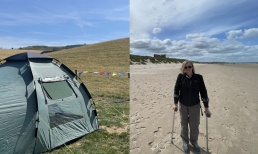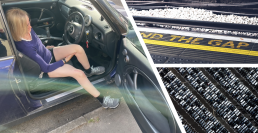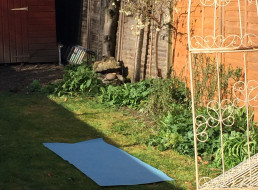Camping, Singing, Walking. Doing things I love with and without crutches.
So this weekend I took my new knee camping! I love being outdoors but I have to admit to feeling nervous about it, post knee replacement. I associate camping with a fair amount of crawling around on my knees as we tend to go to basic campsites, with a small tent and minimal furniture; an inflatable mat not a bed; a low folding chair with no table. In short, not ideal for someone with my range of mobility issues on crutches.
And yet I love being in nature and the simplicity. I don’t go camping for home comforts.
We tried a new campsite this time and, as it turned out, it was the perfect pitch for me. Each camper gets their own little bathroom hut so I had somewhere to sit to get dressed (try pulling a pair of shorts or trousers on if you can’t stand on either leg independently and there’s no seat). There was also picnic table next to each pitch, so I had somewhere to sit at a table and so some variety by switching between this and my camping chair (important if, like me, your hips aren’t level so sitting in one position for more than 30 minutes is painful). All of this meant I only had to get down to the floor once a day, to get into bed, which is now about shuffling on my bum instead of kneeling.
What was also lovely, was being able to walk about the campsite without crutches – just like I do now at home or in the garden. It felt natural. This is a big shift from a month ago on holiday in Northumberland – when I felt much more reliant on crutches for most of the time. Especially walking on sand to experience the dunes at Bamburgh!
Getting off the crutches full stop is still proving difficult. I need to be able to walk for a while and then use the crutches once I’m tired – and so build up that distance. But that would mean carrying them until I need them, which of course changes my gait. I need my arms free to help me balance. I started walking up and down our road to build strength, but the pavements slope which knocks me off balance. I’m going anywhere crowded, I need my crutches to keep other people at a distance – it’s a visual clue for them to slow down and give me space.
I also need them to stand for any length of time, my knee and my feet (in their new orthotics position) get tired without the extra support. I’ve loved getting back to singing in choirs, and of course it’s been possible to mix sitting and standing in rehearsals. I’ve only taken part in short concerts to date. My first longer concert, where I have to hold music, is not until November and I’m grateful for that break to build my strength. I don’t have the ideal physiology to be a singer where posture is so vital and it requires stamina.
Then again, I don’t have the ideal physiology for camping or walking either! As Steps say, people with DDH can’t take walking for granted.
I’ve been at this stage before - after my hip replacement this last part of rehab felt so slow. I had one leg I could rely on then; despite my hip dysplasia being bilateral, in reality my left side was my weak side, my right was more dependable. This time it’s 50/50 which side is more stable.
I know it will happen. I have faith there will be that point where I forget to pick up my crutches and it feels more normal without than with them. Until then I need to do more swimming – perhaps with flippers – and more walking in the garden. Not just pottering but consciously counting my steps without crutches.
Jill Pringle was born with hip dysplasia (DDH). She’s had numerous surgeries including closed and open reductions, leg lengthening, and total hip and knee replacements. Jill’s blog is all about embracing being differently-abled.
Mind the gap, find the gap! Trains, parking and the social model of disability.
In the last two weeks I have taken my first train journey and my first solo drive in the car, since my op. Such big steps forward in lots of ways. As it turns out they were very hard steps to take on crutches with poor balance.
I’m in this weird period right now where neither leg is the good, dependable one, and that’s a first for me. It’s really reminded how differently-abled I can be and what the social model of disability is getting at.
Mind the Gap – the train journey
I’ve had intermittent periods on crutches my whole life. I’m pretty mobile on them, relatively quick vs. a novice, and accustomed to using them on public transport. But my first trip into London by train since my knee replacement, was just horrible.
I remembered to take a train 30 minutes earlier than necessary, so I had time for lifts in connecting stations and take my time across a busy London concourse like Victoria. But getting on, and particularly off the train to change, was more difficult than I expected. Clapham Junction is an amazing feat of engineering and I’m always in awe of how many lives it connects every hour. But the platforms are curved, the train leans away from the track and the chasm that awaits when the doors open is huge in both height and width. Before my op I was handling this by taking weight on my right leg. Now it’s Hobson’s Choice which leg is the weaker. Kind people on the platform try to help, but essentially try and grab my arms (which stops the crutches doing their job and puts my weight on the legs I’m trying not to rely on).
I finally got off with a lurch and a hope. It hurt a bit but I was mostly relieved that I didn’t fall into either the gap or the crowd waiting to get on the train. It’s safe to say that by the time I got to where I was going I was quite traumatised really. And so spent most of my lovely first Choir rehearsal in London dreading the journey home.
Next week I’ll be trying this journey again. I will try to find staff at the station and the right door for the guard on the train, so I can warn them I may need assistance at Clapham. Which, of course, requires more time and planning.
There is nothing easily done about this; old Victorian platforms were not built with disability in mind and I’m not suggesting that Clapham has to be rebuilt, for me. I also know that for some people it’s much harder; they have to call ahead to pre-arrange travel to even get access, and I also know that others in the DDH community would love to walk as far as I can on crutches. We’re all different.
It was simply an eye-opener into travelling with a disability - that I’d forgotten. For a while, I suppose, I’d taken trains for granted.
Find the Gap – the car park
I can now drive about 40 minutes without pain in my right knee or hip flexor. Which means I no longer need my partner to arrange his day around any medical appointments. That’s great for both of us, it gives me independence and I’m grateful for it.
But I always experience the background anxiety of “where am I going to park?” I need to make sure I can get out of the car and then be even more certain I can get back in it when I return!
I am able to walk too far (even on crutches) to qualify for a blue badge. I certainly don’t usually need to be right next to the door of a shop (unless I’m carrying a shopping bag in which case it’s a shuffle, placing the bag down on the pavement every few yards).
The big car parking challenge for someone like me is finding a space at the end of a row, where I can open my car door either into a grass verge, a pavement or the road – so that I can get the door all the way out. I need this clearance to swing my legs out and round together (without full flexion in my knee) and then I need to use the door to lift myself up out of the seat. I can’t go in and out sideways one leg at a time. Once I can stand up I need to turn around, lean into the back seat or over to the passenger seat, get the crutches out, put them in my arms and then close the door. Let’s just say it takes a while. Most people are patient and wait. Most.
On the way into a car park, I do at least have the chance to control this - finding the most suitable space or if there are only narrow spaces left, leave. What might happen on the way out is always on my mind. I have mini. If I can’t find an end space then I have to leave enough space next to me to get out at the side. Someone with a big car or van invariably sees the next space as a great place to park - it gives them plenty of room. Why wouldn’t they? It makes perfect sense and they don’t know that I need that extra room. So I return to my car and can’t get open the door even a fraction. Pre-op, I would have gone in the other side and scutched across the seats and hand break as my knee, whilst painful, was hypermobile and very loose. Less of an option now where bending is more challenging the knee is more robust.
So the options are to contort and cause myself some pain and potentially put some things in my upper body out of alignment for a couple of hours; or if it’s too tight, wait for them to come back to their car. The only other alternative is to park in a disabled or parent and toddler space and hope I don’t get a fine. Hopefully I get the can just find an end space.
Again, I’m not alone in this, many older people without a lifelong disability have the same challenge. And I’m happy to be finally out and about. It’s just this is on my mind from the minute I consider the trip, weighing up do I go out to this thing and risk it, or not.
The social model of disability
My reason for sharing this is not to rant or ask for sympathy. I don’t resent others’ mobility and if you have it you should use it – I would! I have a pretty ‘it is what it is’ attitude borne from 50 years being a differently-abled walker with huge variation my mobility across different periods – sometimes highly disabled by the world around me, other times not much.
Since part of my motivation for creating this blog is to share what it’s like living and walking with just one limiting condition, I simply want to share my experience. And ask you to take just a moment to consider what you might take for granted.
If you want to learn more about the social model of disability, there’s a great 3 minute video on the Scope website here that explains it well.
Thanks for reading. Until the next journey…
Jill Pringle was born with bilateral hip dysplasia in 1971. She has had numerous surgeries as both a child and adult, including open reductions, leg lengthening, and both hip and knee replacements. She writes this blog and walks to raise money for Steps Charity – you can donate here.
The 'Wonky Dog'. Yoga and hip dysplasia.
So I got up this morning and decided that I was definitely going to seize up if I didn't take action to get more exercise during the collective lockdown. For the last few days I have gone out for a daily walk - at safe distance - but my body is so used to its morning swim, and monthly osteo visit, that it's starting to really object. The swimming pool has always been the one place where my body doesn't feel lopsided, and it totally relaxes. Rather than feeling like exercise it feels like giving my brain and my muscles a rest. Like everyone I've got to find a new way of doing things when what we would normally do isn't an option for very good reason.
My drawings for a pop-up olympic pool in our back garden quickly proved that I was missing most of what I needed - the space, the materials, the ability to build anything. And so I turned to my dusty yoga mat. I used to attend yoga classes in my late 20s and through my 30s, but have got out of practice in favour of swimming.
I remember my first ever Yoga class. Well actually I tried Pilates first but when I couldn't complete any of the warm up exercises I felt too awkward to return. But for some reason, in the Yoga class I could at least do something approximating the poses. And the class teacher was happy to let me get close to poses or do alternatives rather than try and push me into a pose.
And so my sun salutations this morning were my own 'hippy' version. And it was just what I needed. Achieving perfect balance between left and right when the two sides of my body aren't built the same would be a futile exercise. And so I work each side of my body as it needs, and I just skip the bits that aren't possible. The point is I'm doing it. And my muscles and mind felt the immediate benefit.
And I have invented three of my own Yoga poses. The wonky dog. The slanty plank. And it finishes off with the hippy shake (yep, sort of dancing it out).
What are you all doing to keep yourselves moving? I'd love to hear from you.
Stay safe, follow the guidelines, and do whatever exercise your hips need to keep mobile.



